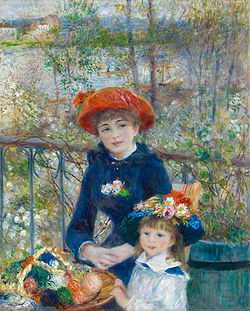- Painted in 1876 by French artist Pierre-Auguste Renoir
- Musee d'Orsay in Paris (I've been there!)
- Possibly the most famous impressionist painting
- Depicts an afternoon in Montmartre in Paris, late 19th century, working class gathered to socialize
- "It shows a richness of form, a fluidity of brush stroke, and a flickering light" -Wiki
"Renoir painted a smaller version of the picture (78 × 114 cm) with the same title. This painting is in a private collection. For many years it was owned by John Hay Whitney. On May 17, 1990, his widow sold the painting for US$78 million at Sotheby's in New York City to Ryoei Saito (Saitō Ryōei), the honorary chairman of Daishowa Paper Manufacturing Company, Japan. At the time of sale, it was one of the top two most expensive artworks ever sold, together with van Gogh's Portrait of Dr. Gachet, which was also purchased by Saito. Saito caused international outrage when he suggested in 1991 that he intended to cremate both paintings with him when he died. However, when Saito and his companies ran into severe financial difficulties, bankers who held the painting as collateral for loans arranged a confidential sale through Sotheby's to an undisclosed buyer.[1] Although not known for certain, the painting is believed to be in the hands of a Swiss collector."
"This painting is doubtless Renoir's most important work of the mid 1870's and was shown at the Impressionist exhibition in 1877. Though some of his friends appear in the picture, Renoir's main aim was to convey the vivacious and joyful atmosphere of this popular dance garden on the Butte Montmartre. The study of the moving crowd, bathed in natural and artificial light, is handled using vibrant, brightly coloured brushstrokes. The somewhat blurred impression of the scene prompted negative reactions from contemporary critics.
This portrayal of popular Parisian life, with its innovative style and imposing format, a sign of Renoir's artistic ambition, is one of the masterpieces of early Impressionism."
About Renoir's style:
"Renoir's paintings are notable for their vibrant light and saturated color, most often focusing on people in intimate and candid compositions. The female nude was one of his primary subjects. In characteristic Impressionist style, Renoir suggested the details of a scene through freely brushed touches of color, so that his figures softly fuse with one another and their surroundings.
His initial paintings show the influence of the colorism of Eugène Delacroix and the luminosity of Camille Corot. He also admired the realism of Gustave Courbet and Édouard Manet, and his early work resembles theirs in his use of black as a color. As well, Renoir admired Edgar Degas' sense of movement. Another painter Renoir greatly admired was the 18th century master François Boucher.[14]
A fine example of Renoir's early work, and evidence of the influence of Courbet's realism, is Diana, 1867. Ostensibly a mythological subject, the painting is a naturalistic studio work, the figure carefully observed, solidly modeled, and superimposed upon a contrived landscape. If the work is still a 'student' piece, already Renoir's heightened personal response to female sensuality is present. The model was Lise Tréhot, then the artist's mistress and inspiration for a number of paintings.[15]
In the late 1860s, through the practice of painting light and water en plein air (in the open air), he and his friend Claude Monet discovered that the color of shadows is not brown or black, but the reflected color of the objects surrounding them, an effect today known as diffuse reflection. Several pairs of paintings exist in which Renoir and Monet, working side-by-side, depicted the same scenes (La Grenouillère, 1869).[16][17]
One of the best known Impressionist works is Renoir's 1876 Dance at Le Moulin de la Galette (Bal du moulin de la Galette). The painting depicts an open-air scene, crowded with people, at a popular dance garden on the Butte Montmartre, close to where he lived.
"The works of his early maturity were typically Impressionist snapshots of real life, full of sparkling colour and light. By the mid 1880s, however, he had broken with the movement to apply a more disciplined, formal technique to portraits and figure paintings, particularly of women, such as The Bathers, which was created during 1884–87. It was a trip to Italy in 1881, when he saw works by Raphael and other Renaissance masters, that convinced him that he was on the wrong path, and for the next several years he painted in a more severe style, in an attempt to return to classicism.[18] This is sometimes called his "Ingres period", as he concentrated on his drawing and emphasized the outlines of figures.[19]
After 1890, however, he changed direction again, returning to thinly brushed color to dissolve outlines as in his earlier work. From this period onward he concentrated especially on monumental nudes and domestic scenes, fine examples of which are Girls at the Piano, 1892, and Grandes Baigneuses, 1887. The latter painting is the most typical and successful of Renoir's late, abundantly fleshed nudes.[20]
A prolific artist, he made several thousand paintings. The warm sensuality of Renoir's style made his paintings some of the most well-known and frequently-reproduced works in the history of art. The single largest collection of his works—181 paintings in all—is at the Barnes Foundation, near Philadelphia, Pennsylvania.'"



